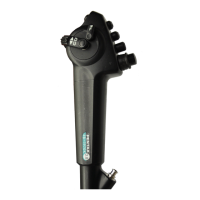– 9 –
General
1
This IFU contains detailed recommendations on the manual reprocessing of
PENTAX endoscopes using PENTAX supplied cleaning/disinfecting adapters.
AERs may also be used to reprocess flexible endoscopes. However, only
those AERs should be used whose manufacturers provide device-specific
instructions and have validation data to support each AER claim with respect
to PENTAX instruments. AER manufacturers should be consulted for their
specic claims including, but not necessarily limited to:
a) the ability of the AER to provide a cleaned and high-level disinfected (or
sterilized) endoscope and endoscope components (e.g., valves),
b) the identification of any special feature (internal channel) or endoscope
component that cannot be reprocessed and therefore requires manual
reprocessing,
c) the microbial quality of the rinse water,
d) the inclusion of an “automated” alcohol rinse cycle,
e) the inclusion of a terminal drying cycle that removes the majority of water
from within endoscope channels,
f) maintenance procedures for water filter replacement and/or
decontamination of the filtration system to ensure water of suitable
quality,
g) compliance with local regulations and/or guidelines.
PENTAX exible endoscopes should not be exposed to temperatures in excess
of 140
o
F (60
o
C) during either reprocessing or storage. During reprocessing
depending
upon the detergent used, the endoscope may be damaged even
if
the
temperature
does
not
exceed
140
o
F (60
o
C). A list of detergents that are
compatible with PENTAX endoscopes is contained in this manual.
All of the steps in the validated reprocessing protocol described in this
manual are intended to be performed in rapid succession and as a single,
continual procedure. There should be no breaks in between steps of the
protocol that are of sufficient duration to permit the endoscope to dry to
such an extent that dislodged debris and/or microbial contaminants would be
permitted to dry onto any endoscope surface. In the event that drying of the
endoscope occurs due to an excessive break in the reprocessing procedure,
the procedure should be completely repeated, beginning with the rst pre-
cleaning step.

